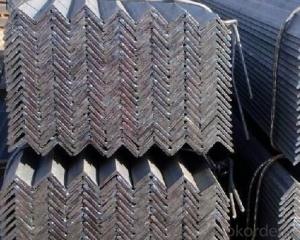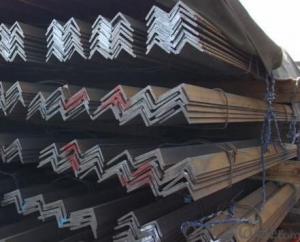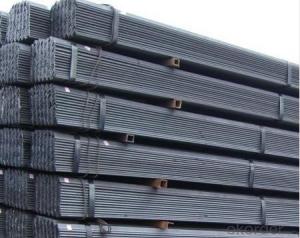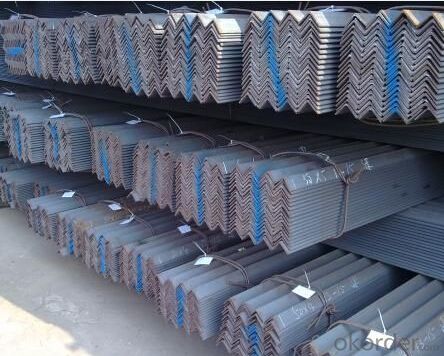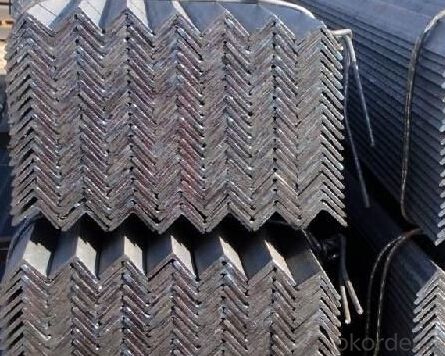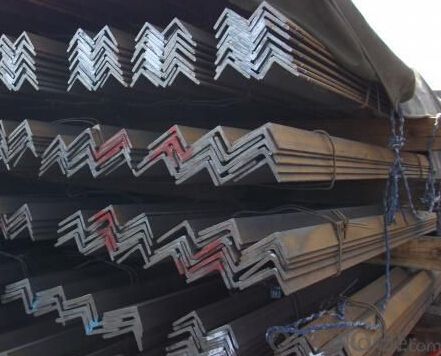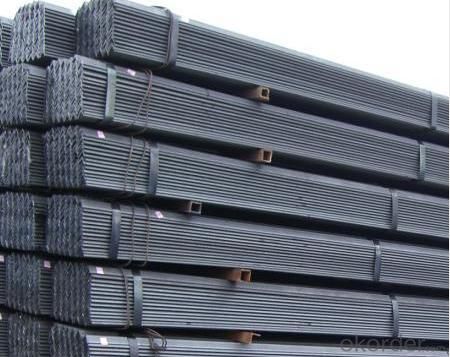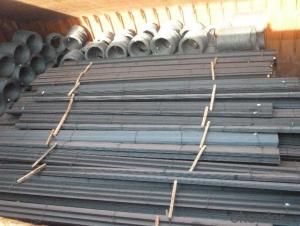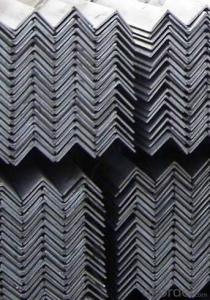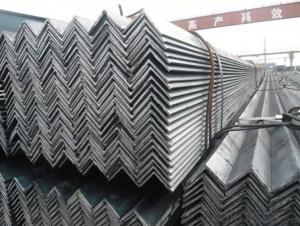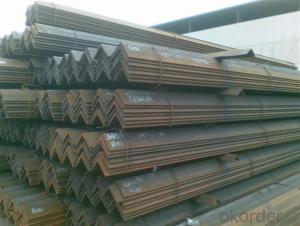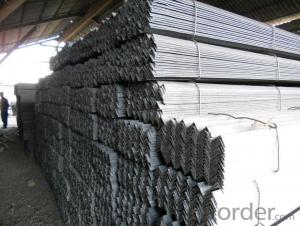Angle Steel with Material: GB Q235B, Q345B
- Loading Port:
- China main port
- Payment Terms:
- TT or LC
- Min Order Qty:
- 100 m.t.
- Supply Capability:
- 5000 m.t./month
OKorder Service Pledge
OKorder Financial Service
You Might Also Like
Product Description:
OKorder is offering Angle Steel with Material: GB Q235B, Q345B at great prices with worldwide shipping. Our supplier is a world-class manufacturer of steel, with our products utilized the world over. OKorder annually supplies products to European, North American and Asian markets. We provide quotations within 24 hours of receiving an inquiry and guarantee competitive prices.
Product Applications:
Angle Steel with Material: GB Q235B, Q345B are ideal for structural applications and are widely used in the construction of buildings and bridges, and the manufacturing, petrochemical, and transportation industries.
Product Advantages:
OKorder's Angle Steel with Material: GB Q235B, Q345B are durable, strong, and resist corrosion.
Main Product Features:
· Premium quality
· Prompt delivery & seaworthy packing (30 days after receiving deposit)
· Corrosion resistance
· Can be recycled and reused
· Mill test certification
· Professional Service
· Competitive pricing
Product Specifications:
1. Standards: GB,ASTM,BS,AISI,DIN,JIS
2. Invoicing on theoretical weight or actual weight as customer request
3. Material:Material: GB Q235B, Q345B or Equivalent; ASTM A36; EN 10025, S235JR, S355JR; JIS G3192, SS400; SS540.
4. Sizes:
Sizes: 25mm-250mm | ||
a*t | ||
25*2.5-4.0 | 70*6.0-9.0 | 130*9.0-15 |
30*2.5-6.6 | 75*6.0-9.0 | 140*10-14 |
36*3.0-5.0 | 80*5.0-10 | 150*10-20 |
38*2.3-6.0 | 90*7.0-10 | 160*10-16 |
40*3.0-5.0 | 100*6.0-12 | 175*12-15 |
45*4.0-6.0 | 110*8.0-10 | 180*12-18 |
50*4.0-6.0 | 120*6.0-15 | 200*14-25 |
60*4.0-8.0 | 125*8.0-14 | 250*25 |
5. Material details:
Alloy No | Grade | Element (%) | |||||
C | Mn | S | P | Si | |||
|
|
|
|
|
|
| |
Q235 | B | 0.12—0.20 | 0.3—0.7 | ≤0.045 | ≤0.045 | ≤0.3 | |
|
|
|
|
|
|
| |
Alloy No | Grade | Yielding strength point( Mpa) | |||||
Thickness (mm) | |||||||
≤16 | >16--40 | >40--60 | >60--100 | ||||
≥ | |||||||
|
|
|
|
|
| ||
Q235 | B | 235 | 225 | 215 | 205 | ||
Alloy No | Grade | Tensile strength (Mpa) | Elongation after fracture (%) | ||||
Thickness (mm) | |||||||
| ≤16 | >16--40 | >40--60 | >60--100 | |||
≥ | |||||||
|
|
|
|
|
|
| |
Q235 | B | 375--500 | 26 | 25 | 24 | 23 | |
Usage & Applications of GB Q235 Angle Steel
Trusses;
Transmission towers;
Telecommunication towers;
Bracing for general structures;
Stiffeners in structural use.
Packaging & Delivery of GB Q235 Angle Steel
1. Transportation: the goods are delivered by truck from mill to loading port, the maximum quantity can be loaded is around 40MTs by each truck. If the order quantity cannot reach the full truck loaded, the transportation cost per ton will be little higher than full load.
2. With bundles and load in 20 feet/40 feet container, or by bulk cargo, also we could do as customer's request.
3. Marks:
Color mark: There will be color marking on both end of the bundle for the cargo delivered by bulk vessel. That makes it easily to distinguish at the destination port.
Tag mark: There will be tag mark tied up on the bundles. The information usually including supplier logo and name, product name, made in China, shipping marks and other information request by the customer.
If loading by container the marking is not needed, but we will prepare it as customer request.
FAQ:
Q1: Why buy Materials & Equipment from OKorder.com?
A1: All products offered byOKorder.com are carefully selected from China's most reliable manufacturing enterprises. Through its ISO certifications, OKorder.com adheres to the highest standards and a commitment to supply chain safety and customer satisfaction.
Q2: How do we guarantee the quality of our products?
A2: We have established an advanced quality management system which conducts strict quality tests at every step, from raw materials to the final product. At the same time, we provide extensive follow-up service assurances as required.
Q3: How soon can we receive the product after purchase?
A3: Within three days of placing an order, we will begin production. The specific shipping date is dependent upon international and government factors, but is typically 7 to 10 workdays.
A4: Stainless steel must contain at least 10.5 % chromium. It is this element that reacts with the oxygen in the air to form a complex chrome-oxide surface layer that is invisible but strong enough to prevent further oxygen from "staining" (rusting) the surface. Higher levels of chromium and the addition of other alloying elements such as nickel and molybdenum enhance this surface layer and improve the corrosion resistance of the stainless material.
Q5: Can stainless steel rust?
A5: Stainless does not "rust" as you think of regular steel rusting with a red oxide on the surface that flakes off. If you see red rust it is probably due to some iron particles that have contaminated the surface of the stainless steel and it is these iron particles that are rusting. Look at the source of the rusting and see if you can remove it from the surface.
Images:
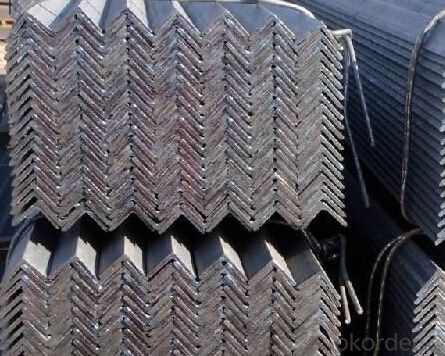
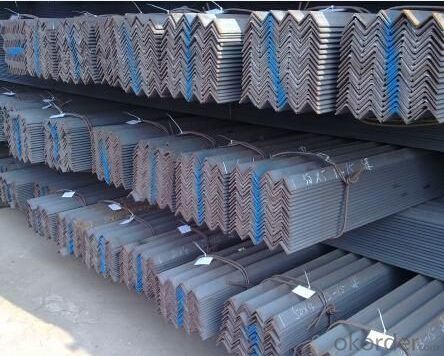
"The angle is perpendicular to each other on both sides of the steel strip into the corner. There are equilateral angle steel and unequal angle points. An equal angle two edge width equal.
The angle is built with carbon steel, is a simple section steel steel, mainly used for metal components and the frame of the plant. In the use of the requirements are good, plastic deformation properties and a certain mechanical strength. The production of raw materials for low carbon steel billet steel billets, finished angle for the hot rolling, normalizing or hot-rolled state of delivery.
The specifications are expressed by the MM number of edges and sides and the thickness of the thick. Such as ""/ 30 x 30 x 3"", that is 30 mm equilateral angle edge width edge thickness was 3 mm. Also available models that model is the number of centimeters wide, such as angle 3#. Model doesn't mean thickness angle of different size in the same model, thus in the edge of the contracts and other documents will be angle width, edge thick size fill in complete, avoid separate model, said. The specifications for 2#-20# hot rolled equilateral angle steel.
The surface quality of the equilateral angle steel are specified in the standard and may not generally require the use of harmful defects, such as delamination, scarring, and cracks. Equilateral angle geometry error allowed range in the standard also provides, in general, including bending, edge width, edge thickness, dip angle and theoretical weight, and provides significant torsional angle not.
Angle according to the different needs of structure composed of a variety of stress components, can also be used as a component of the connections between the. Angle steel is mainly used for manufacturing the frame structure, such as high voltage transmission tower, steel structure bridge girder on both sides of the framework, tower crane of the column and arm lever on the construction site, workshop of column and beam, small place such as festivals roadside put pot in the shape of a shelf, in window hanging solar air conditioning such as shelves.
"
- Q: What are the common uses of unequal steel angles?
- Unequal steel angles are commonly used in construction, engineering, and fabrication projects. They are often used as structural supports, providing stability and strength in frameworks, buildings, and bridges. These angles are also used for creating bracing systems, reinforcing corner joints, and as components in machinery and equipment. Additionally, they are utilized in architectural designs for decorative purposes, adding aesthetic appeal to structures.
- Q: How do steel angles contribute to the overall stability of a truss system?
- Steel angles contribute to the overall stability of a truss system by providing additional support and rigidity to the structure. The angles are typically used as diagonal braces, helping to distribute the load evenly and prevent any excessive deflection or deformation. By reinforcing the truss members and connecting them securely, steel angles enhance the system's ability to withstand external forces and maintain its structural integrity.
- Q: Can steel angles be used in the construction of warehouses?
- Yes, steel angles can be used in the construction of warehouses. Steel angles are commonly used as structural components in various construction projects, including warehouses. They provide strength and stability to the structure, making them suitable for supporting heavy loads and withstanding the demands of warehouse operations. Additionally, steel angles can be easily fabricated, installed, and connected, making them a cost-effective and efficient choice for warehouse construction.
- Q: What are the different grades of steel used in manufacturing steel angles?
- There are several different grades of steel that are commonly used in manufacturing steel angles. These grades vary in terms of their composition, strength, and other properties, and are selected based on the specific requirements of the application. One commonly used grade is mild steel, also known as low carbon steel or A36 steel. This grade is widely available and commonly used due to its affordability and ease of machining. Mild steel angles are often used in general construction and fabrication projects. Another grade is high-strength low-alloy steel (HSLA), which contains small amounts of alloying elements such as copper, phosphorus, niobium, or vanadium. HSLA steels offer higher strength and improved corrosion resistance compared to mild steel, making them suitable for structural applications in heavy machinery or marine environments. There are also higher-strength steels, such as high-strength steel angles (HSS) or ultra-high-strength steel angles (UHSS). These grades are specifically designed to provide exceptional strength and durability, often used in demanding applications such as bridges, high-rise buildings, or automotive components. Stainless steel is another common grade used in manufacturing steel angles. With its excellent corrosion resistance, stainless steel angles are commonly used in food processing, chemical, or marine applications where resistance to rust and staining is crucial. The specific grade of steel used in manufacturing steel angles depends on factors such as load-bearing requirements, corrosion resistance, and cost considerations. Consulting with a structural engineer or steel supplier can help determine the most suitable grade for a particular application.
- Q: What does angle 5 mean?
- Angle called angle, the steel strip is perpendicular to each other on both sides into the corner. There are equal angles and unequal angles. The two sides of an equal angle steel are equal in width.
- Q: How do steel angles contribute to the energy efficiency of a building?
- Steel angles can contribute to the energy efficiency of a building in several ways. Firstly, steel angles are commonly used as structural elements in the construction of buildings. They provide strength and support to the building's framework, allowing for the use of larger windows and open floor plans. This promotes natural daylighting and reduces the need for artificial lighting during the day, thereby reducing energy consumption. Additionally, steel angles can be used to create energy-efficient building envelopes. By incorporating steel angles into the construction of walls, roofs, and floors, thermal bridging can be minimized. Thermal bridging occurs when materials with high thermal conductivity, such as concrete or wood, allow heat to escape or enter the building, leading to increased energy consumption for heating or cooling. Steel, on the other hand, has a low thermal conductivity, which helps to reduce heat transfer and improve the overall thermal performance of the building envelope. Moreover, steel angles can be used in the installation of energy-saving systems and equipment. For instance, they can be used to support solar panels, which generate clean and renewable energy. Steel angles can also be utilized in the installation of HVAC systems, allowing for efficient air circulation and distribution throughout the building. By using steel angles in these applications, the energy efficiency of the building can be enhanced, leading to reduced energy consumption and lower utility bills. In conclusion, steel angles play a significant role in promoting energy efficiency in buildings. They contribute to the structural integrity of the building, help minimize thermal bridging, and can support the installation of energy-saving systems. By incorporating steel angles into the design and construction of a building, energy consumption can be reduced, resulting in a more sustainable and cost-effective built environment.
- Q: Are steel angles suitable for use in high-rise buildings?
- Steel angles are indeed suitable for high-rise buildings. They are frequently utilized as structural elements in such buildings because of their exceptional strength, durability, and versatility. Due to their ability to endure heavy loads and provide structural support, steel angles are ideal for use in beams, columns, and bracing systems. Moreover, they can be easily fabricated and installed, resulting in efficient construction processes. Furthermore, steel angles can be tailored to fit specific structural requirements in terms of size and shape, allowing for flexibility in both design and construction. In conclusion, steel angles are a dependable and cost-effective option for high-rise buildings, as they possess the necessary strength and stability required for such structures.
- Q: How are steel angles supported during installation?
- Steel angles are typically supported during installation using structural supports such as brackets, beams, or frames. These supports ensure the angles are securely held in place, allowing for proper alignment and stability.
- Q: What is the maximum bending moment for a steel angle?
- The maximum bending moment for a steel angle depends on various factors such as the dimensions and properties of the angle, the applied load, and the support conditions. In general, the maximum bending moment occurs at the location where the angle experiences the highest stress due to the applied load. To determine the maximum bending moment for a steel angle, one needs to consider the angle's section modulus (a measure of its resistance to bending), the distance between the applied load and the support, and the magnitude and distribution of the load. The section modulus is calculated based on the angle's dimensions, including its thickness, height, and width. By analyzing the applied load and the support conditions using principles of structural mechanics, engineers can determine the maximum bending moment for a steel angle. This information is crucial for designing and assessing the structural integrity of steel angle components in various applications, such as construction, manufacturing, and infrastructure projects. It is important to note that the maximum bending moment can vary significantly depending on the specific angle's dimensions, material properties, and the applied load. Therefore, it is necessary to consult relevant design codes, standards, or consult a qualified structural engineer for accurate and detailed calculations specific to a particular steel angle.
- Q: What are the common methods of joining or connecting steel angles together?
- Common methods of joining or connecting steel angles together include welding, bolting, and using angle brackets or cleats.
Send your message to us
Angle Steel with Material: GB Q235B, Q345B
- Loading Port:
- China main port
- Payment Terms:
- TT or LC
- Min Order Qty:
- 100 m.t.
- Supply Capability:
- 5000 m.t./month
OKorder Service Pledge
OKorder Financial Service
Similar products
Hot products
Hot Searches
Related keywords

